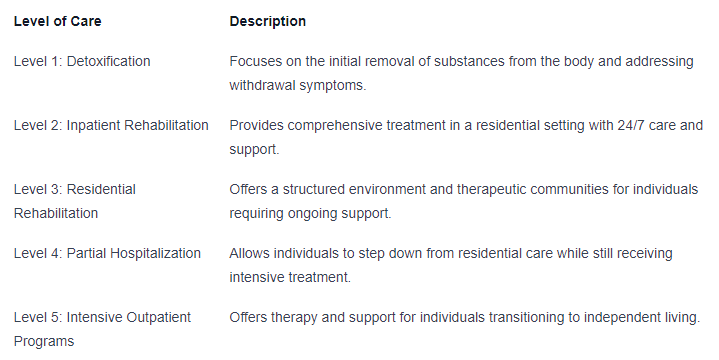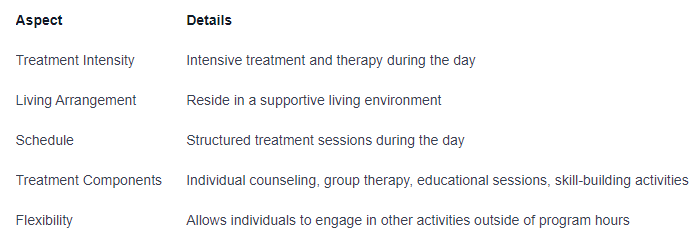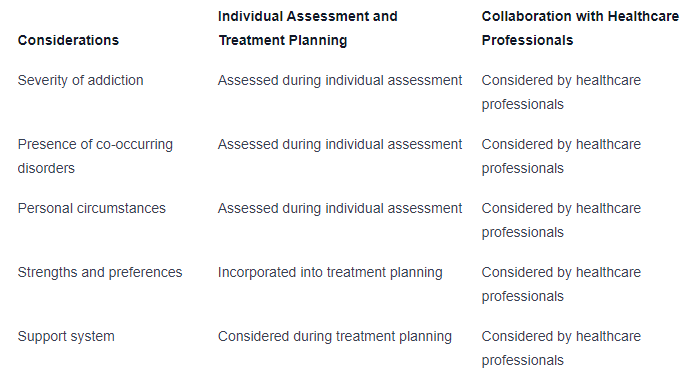The 5 Levels of Care in Rehab

Understanding Rehab and the Levels of Care
Rehabilitation, commonly referred to as rehab, is a comprehensive and structured process that helps individuals recover from various physical, mental, or behavioral health conditions. Rehab aims to restore functioning, improve quality of life, and promote long-term recovery. To facilitate the recovery journey, rehab is typically organized into different levels of care, each offering a unique set of services and support.
What is Rehab?
Rehab refers to a range of services and interventions designed to address the specific needs of individuals dealing with substance abuse, mental health disorders, physical injuries, or other conditions affecting their daily functioning. The goal of rehab is to provide individuals with the tools, skills, and support necessary to overcome their challenges and achieve a healthier and more fulfilling life.
Rehabilitation programs are typically tailored to the individual's needs and may include a combination of medical, therapeutic, and psychosocial interventions. These programs are delivered in various settings, ranging from specialized facilities to outpatient clinics, depending on the level of care required.
The Importance of Different Levels of Care
Different individuals have different needs and varying levels of support required during the recovery process. This is why rehab is organized into distinct levels of care, each offering a specific intensity of treatment and support. The levels of care ensure that individuals receive the appropriate level of supervision, structure, and therapy based on their unique circumstances.
By progressing through the levels of care, individuals can transition from more intensive and structured settings to more independent living while still receiving the necessary support. This allows for a gradual reintegration into society and fosters a sustainable recovery process.
Here is an overview of the 5 levels of care in rehab:

Understanding the different levels of care in rehab is crucial for individuals and their healthcare professionals to determine the most appropriate level of support needed. This decision is typically based on factors such as the severity of the condition, the individual's support system, and their ability to function independently.
Rehab provides a continuum of care that helps individuals progress towards recovery, develop coping skills, and establish a solid foundation for long-term success. By tailoring the level of care to the individual's needs, rehab aims to optimize the chances of achieving sustained recovery and improved overall well-being.
Level 1: Detoxification
Detoxification is the first level of care in the rehabilitation process. Its primary purpose is to help individuals safely and effectively rid their bodies of harmful substances, such as drugs or alcohol. This crucial step sets the foundation for further treatment and recovery.
Purpose of Detoxification
The main goal of detoxification is to manage the physical and psychological symptoms of withdrawal that occur when a person stops using substances. It is essential to undergo this process under medical supervision to ensure the safety and well-being of the individual.
During detoxification, the body goes through a period of adjustment as it eliminates toxins and adjusts to functioning without the substances it has become dependent on. The specific duration and intensity of detoxification can vary depending on various factors, including the type and duration of substance use, individual health, and the presence of co-occurring medical or mental health conditions.
Detoxification not only helps individuals overcome the physical aspects of addiction but also prepares them for the subsequent levels of care in the rehabilitation process. It provides a solid starting point by ensuring that the individual is stable and ready to engage in further treatment.
Medical Supervision and Support
Detoxification requires medical supervision and support to manage the potential challenges and risks associated with withdrawal. Healthcare professionals, such as doctors, nurses, and addiction specialists, closely monitor individuals undergoing detoxification to ensure their safety and comfort.
During this level of care, medical professionals may administer medications to alleviate withdrawal symptoms and reduce the risk of complications. They also provide round-the-clock support, assessing vital signs, monitoring progress, and addressing any emergent needs that may arise.
Detoxification may take place in various settings, including hospitals, specialized detoxification centers, or rehab facilities equipped to provide medical supervision. The specific setting will depend on the individual's needs, the substances involved, and the severity of withdrawal symptoms.
By providing structured medical support and addressing the physical aspects of addiction, detoxification sets the stage for individuals to progress to the subsequent levels of care in their rehabilitation journey. It is an essential step in the overall recovery process, ensuring a safe and effective transition to the next phase of treatment.
Level 2: Inpatient Rehabilitation
Inpatient rehabilitation is a crucial level of care in the journey towards recovery. This level provides individuals with a structured and supportive environment to overcome their addiction and work towards a healthier, sober life.
Comprehensive Treatment Programs
Inpatient rehabilitation facilities offer comprehensive treatment programs that address the physical, emotional, and psychological aspects of addiction. These programs are tailored to meet the individual needs of each patient, ensuring a personalized approach to recovery.
The treatment programs in inpatient rehabilitation typically include a combination of therapies, counseling, and educational sessions. Group therapy allows individuals to connect with peers who are going through similar experiences, fostering a sense of community and support. Individual therapy sessions provide a one-on-one setting where patients can explore their personal challenges and develop coping mechanisms.
Furthermore, inpatient rehabilitation programs often incorporate alternative therapies such as art therapy, yoga, and meditation. These therapies help individuals explore creative outlets and learn relaxation techniques that can aid in managing stress and cravings.
24/7 Care and Support
One of the key advantages of inpatient rehabilitation is the round-the-clock care and support provided by a multidisciplinary team of healthcare professionals. This level of care ensures that individuals have access to immediate assistance and supervision whenever needed.
The presence of medical and clinical staff, including doctors, nurses, therapists, and counselors, allows for comprehensive monitoring of physical and mental health. This continuous support helps individuals navigate the challenges of withdrawal symptoms, emotional distress, and cravings that may arise during the recovery process.
Inpatient rehabilitation facilities prioritize creating a safe and supportive environment for patients. This involves implementing strict rules and regulations to maintain sobriety within the facility. By removing individuals from their regular environment and daily triggers, inpatient rehabilitation minimizes the risk of relapse and provides a focused atmosphere for recovery.
While inpatient rehabilitation offers intensive care and support, it is essential to note that the duration of this level of care may vary based on individual needs and progress. The goal is to equip individuals with the necessary tools and skills to transition to the next level of care successfully.
In the next section, we will explore level 3 of care in rehab - residential rehabilitation, which provides individuals with a structured and therapeutic community environment to further their recovery journey.
Level 3: Residential Rehabilitation
Residential rehabilitation, also known as inpatient rehab, is a crucial level of care in the recovery journey. This level of care provides individuals with a structured and supportive environment to focus on their healing and recovery. Let's explore the key features of residential rehabilitation: a structured environment and therapeutic communities.
Structured Environment
Residential rehabilitation offers a highly structured environment that is conducive to recovery. Patients reside in a facility specifically designed to support their rehabilitation journey. The structured environment provides a sense of stability and routine, which can be instrumental in helping individuals break free from unhealthy habits and patterns.
In a residential rehab setting, individuals typically follow a carefully planned daily schedule. This schedule includes a combination of individual therapy sessions, group therapy activities, educational workshops, and recreational activities. The structured environment ensures that individuals have a well-rounded and comprehensive treatment experience.
Therapeutic Communities
One of the key aspects of residential rehabilitation is the concept of therapeutic communities. These communities are made up of individuals who are going through similar challenges and are committed to their recovery. The sense of belonging and support within these communities can be immensely beneficial for individuals in rehab.
Within a therapeutic community, individuals have the opportunity to share their experiences, learn from one another, and provide mutual support. This sense of camaraderie fosters a supportive and understanding environment where individuals can feel safe to express themselves and work on their recovery goals.
Therapeutic communities also encourage accountability and responsibility. Residents are expected to actively participate in the community, contribute to household chores and responsibilities, and adhere to the rules and regulations set by the facility. This promotes a sense of structure and discipline, helping individuals develop important life skills that are essential for long-term recovery.
Residential rehabilitation plays a crucial role in the overall recovery process by providing individuals with a structured environment and access to therapeutic communities. This level of care offers the necessary support and resources for individuals to focus on their healing and make significant progress towards a healthier and more fulfilling life.
Level 4: Partial Hospitalization
Step-Down from Residential Rehabilitation
Partial hospitalization serves as a transitional level of care for individuals who have completed residential rehabilitation but still require intensive treatment and support. It offers a structured environment with a focus on continued recovery and reintegration into daily life.
During this phase, individuals typically reside in a supportive living arrangement, such as a sober living house or a transitional residence. They attend treatment sessions during the day and return to their designated living environment in the evenings. This step-down approach allows for a gradual transition from the highly structured residential setting to a more independent living situation.
Intensive Treatment with Flexibility
Partial hospitalization programs provide individuals with intensive treatment and therapy, similar to residential rehabilitation. The treatment plans are tailored to each person's specific needs, addressing their unique challenges and goals. The program typically includes a combination of individual counseling, group therapy, educational sessions, and skill-building activities.
One of the key advantages of partial hospitalization is the flexibility it offers. It allows individuals to receive treatment during the day while still having the freedom to engage in other activities outside of the program hours. This flexibility is particularly beneficial for those who are transitioning back into work, school, or family responsibilities.
The table below provides a summary of the key aspects of partial hospitalization:

Partial hospitalization plays a vital role in supporting individuals as they continue their journey towards recovery. It provides the necessary level of care and support while empowering individuals to gradually reintegrate into their daily lives. The flexible nature of this level of care allows for a balance between treatment and individual responsibilities, fostering a sustainable path to long-term recovery.
Level 5: Intensive Outpatient Programs
As individuals progress in their recovery journey, they may transition to Level 5 of care in rehab, which involves participation in intensive outpatient programs. These programs provide continued support and therapy while allowing individuals to gradually transition to independent living.
Transitioning to Independent Living
Intensive outpatient programs offer individuals the flexibility to live at home or in a sober living environment while attending scheduled treatment sessions. This level of care is suitable for individuals who have completed higher levels of care but still require ongoing support as they reintegrate into their daily lives.
The transition to independent living in Level 5 involves gradually assuming more responsibilities and rebuilding a stable routine. Participants in intensive outpatient programs have the opportunity to apply the skills they have learned during their earlier stages of treatment in real-life situations. This gradual transition helps individuals develop confidence in managing their recovery while still receiving the necessary support.
Continued Support and Therapy
Intensive outpatient programs provide continued support and therapy to individuals in their recovery journey. These programs typically involve a combination of individual counseling, group therapy sessions, and educational workshops. The frequency and duration of these sessions may vary based on individual needs and program structure.
The continued therapy in Level 5 aims to reinforce relapse prevention strategies, coping skills, and emotional well-being. Participants have the opportunity to explore and address underlying issues that may contribute to substance abuse or addictive behaviors. Additionally, the supportive group environment fosters a sense of community and connection with others who are also navigating the challenges of recovery.
It's important to note that intensive outpatient programs still require a commitment to regular attendance and active participation. Compliance with program guidelines and a dedication to personal growth are essential for individuals to make the most of this level of care.
By providing a structured yet flexible approach, Level 5 of care in rehab helps individuals transition back into their communities while maintaining the necessary support and therapy. It enables individuals to apply the skills they have acquired, further develop their recovery strategies, and build a solid foundation for long-term sobriety.
Choosing the Right Level of Care
When it comes to rehab, choosing the appropriate level of care is essential for a successful recovery journey. This decision is based on individual assessment and treatment planning, as well as collaboration with healthcare professionals who specialize in addiction and recovery.
Individual Assessment and Treatment Planning
Choosing the right level of care starts with a comprehensive individual assessment. During this assessment, healthcare professionals evaluate various factors including the severity of the addiction, the presence of any co-occurring disorders, and the individual's personal circumstances. This assessment helps in determining the most suitable level of care that will address the specific needs of the individual.
Treatment planning is the next step in the process. It involves creating a personalized treatment plan based on the assessment results. This plan outlines the goals, strategies, and interventions that will be implemented to support the individual's recovery. The treatment plan takes into account the individual's strengths, preferences, and any specific challenges they may face.
Collaboration with Healthcare Professionals
Collaboration with healthcare professionals is crucial in choosing the right level of care in rehab. These professionals, such as doctors, therapists, and addiction specialists, have the expertise and knowledge to guide individuals and their families through the decision-making process.
Healthcare professionals provide valuable insights into the various levels of care available and their suitability for different individuals. They consider factors such as the severity of the addiction, the presence of any co-occurring disorders, the individual's support system, and their personal circumstances. This collaborative approach ensures that the chosen level of care aligns with the individual's needs and maximizes the chances of successful recovery.
The table below provides a summary of the key considerations when choosing the right level of care:

By undergoing a thorough individual assessment, creating a personalized treatment plan, and collaborating with healthcare professionals, individuals can choose the level of care that best supports their recovery journey. This collaborative approach ensures that the chosen level of care is tailored to their unique needs, increasing the likelihood of successful rehabilitation and long-term recovery.
Conclusion
In conclusion, choosing the appropriate level of care in rehab is crucial for individuals seeking to overcome addiction and achieve long-term recovery. Each level of care provides unique benefits and support, from intensive inpatient rehabilitation to flexible outpatient programs. By undergoing a comprehensive individual assessment, collaborating with healthcare professionals, and creating a personalized treatment plan, individuals can choose the level of care that aligns with their specific needs and maximizes their chances of successful rehabilitation.
With dedication, commitment, and support, individuals can overcome addiction and build a fulfilling life in recovery.
